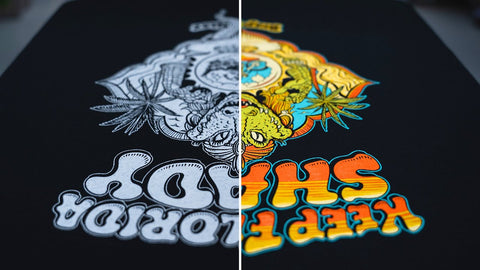Syndicated by One Source Media, Long Island City, New York
New screen printers should start off printing with plastisol ink. It’s more forgiving than water-based ink and it’s much easier to achieve proper cure. Even though printing plastisol is more straightforward, there are many techniques to print the ink for various processes. We’ve created a collection of videos and blogs that explain how to print with plastisol ink in different situations.

HOW TO SCREEN PRINT WHITE PLASTISOL INK ON A DARK GARMENT USING A SMOOTHING SCREEN
Printing white ink on a dark garment is not a simple task. Screen printing genius Colin Huggins goes over best practices for printing white plastisol ink on a black shirt. Got a notebook and pencil handy? Right, let’s learn how to print white ink on a dark garment and make the print as bright and clean as possible.
WATCH THE VIDEO

CURING PLASTISOL INK WITH A FLASH DRYER
Dryers can cost a pretty penny, especially when you’re starting to build your shop. Many screen printers will use their flash dryers to cure. Flash dryers get the job done, but there are some tips and tricks to ensuring your print becomes completely cured. Our in-house expert Colin Huggins goes in-depth about how to properly cure plastisol ink, specifically FN-INK™, with a flash dryer in our latest video.
WATCH THE VIDEO

HOW TO ACHIEVE SOFT-HAND PRINTS USING PLASTISOL INK
Want soft-hand prints? Print with water-based inks.
Well, water-based printing isn’t accessible to every printer. Luckily, there are some things you can do to make your plastisol prints softer. Between the inks you choose to use, the garments you’re printing on, to the available ink additives, achieving soft plastisol prints is very possible. Let’s take a look to see how to accomplish this goal.
READ FULL POST

FOUR WAYS TO PRINT BLACK PLASTISOL INK ON BLACK SHIRTS
Printing black ink on a black shirt — trendy, right? As with everything in screen printing, there are multiple ways to achieve this goal. From using a puff base to printing with clear base to curing at higher and lower temperatures, printers can offer a variety of effects and looks to their customers. Let’s take a look to see how each technique turns out so you can decide what’s best for your next print job.
WATCH THE VIDEO

HOW TO MAKE PLASTISOL HEAT TRANSFERS
Screen printing heat transfers can seem daunting but in reality, it’s fairly simple. If made properly, plastisol heat transfers can last almost as long as a standard screen print and can be much easier to apply in certain scenarios like decorating hats, neck labels, names for sport apparel, and more.
Let’s walk through the basic components and process of screen printing your own heat transfers.
WATCH THE VIDEO

EVERYTHING YOU NEED TO KNOW TO SCREEN PRINT AN UNDERBASE
Knowing how to screen print an underbase is crucial for screen printers. If you want a bright, vivid print, you’ll need to lay down a solid white base. Rogue Lab Owner Lee Stuart breaks down the steps on how to achieve a fantastic underbase.
WATCH THE VIDEO

ENSURING PROPER INK CURING
Curing your prints is one of the last steps of the screen printing process, but it is one of the most important steps. Ink needs to be cured properly so it sets into the garment. If the ink does not cure fully, it will crack, fall apart, and not last for long. Printers use either heat guns, heat presses, flash dryers, or conveyor dryers to cure inks. Let’s take a look at how each curing device works.
READ FULL POST

HOW TO HANDLE WHITE PLASTISOL INKS IN COOLER TEMPERATURES
Dreaming about warm summer days when your ink flows oh so smoothly? Winter and its cooler temperatures sure makes it difficult for a screen printer, especially with white plastisol inks. The ink feels thick, stringy, and stiff. It requires more effort to lay down a good ink deposit. Does it have to be this hard? Nope. Ink and Chemistry Guru Colin Huggins shares his secrets to making white plastisol ink easier to handle during the cooler months.
READ FULL POST

HOW TO PRINT BLACK PLASTISOL INK ON A WHITE GARMENT
We learned about printing white plastisol ink on a black shirt, but what about black plastisol ink on a white shirt? In our latest video, expert Colin Huggins explores the nuances of printing black plastisol ink on light-colored garments.
WATCH THE VIDEO

HOW TO ACHIEVE MATTE OR GLOSSY PRINTS
Wondering how to adjust the final looks of the ink? (Is it too shiny? Want it to look dull? Or is it dull and you want it to look shiny?) Let’s look into it.
READ FULL POST

HOW TO SCREEN PRINT WET ON WET HALFTONES AND COLOR BLENDS FOR A VINTAGE LOOK
Remember when expert Colin Huggins showed how to create halftones and blends in Adobe Illustrator? Now he’s printing that design. Watch to learn how to print wet-on-wet halftones and blends, tips to get the best colors and blends, and how shirt colors affect the look of the print.
WATCH THE VIDEO
* This article was originally published here
Find One Source Media on Google Maps: https://www.google.com/maps?cid=5313632701819553670
